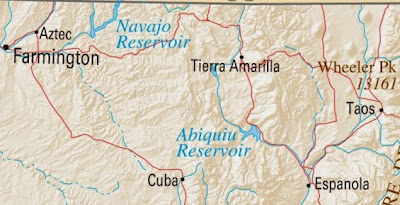Diego de Vargas left Nuevo México believing local indios bárbaros fell into two groups: Athabaskan speakers and Shoshone speakers. Navajo and Apache were grouped together in the first, Ute and Comanche in the second.
When he returned in 1703, differences between bands were becoming clear. Navajo attacked from the north and west. Faraón Apache came from the east.
In 1704, de Vargas led a force against the Faraón in the Sandías that mustered in Bernalillo. The war captain from Santa Clara, Juan Roque, was there with four men. Lorenzo brought five men from San Juan.
By the time Francisco Cuervo arrived to replace de Vargas in 1705, the Navajo had become more dangerous. They attacked San Juan, Santa Clara, and San Ildefonso twice. He immediately stationed presidio troops at the most exposed points, including Santa Clara on the west side of the Río Grande.
In March, Roque de Madrid pursued them with 65 men. They included soldiers from the presidio, the men assigned to Santa Clara, and the militia. In August, Cuervo sent him north from San Juan to follow the Navajo into their homeland. He went through uncharted territory north of Taos and west of the Continental Divide. When he returned he remarked, "we could make war on them again with greater advantage than at present, because all the men are now experienced in this land, the ways in and out, and we would return with more food."
The Navajo had made peace with Cuervo, not with the entity called Nuevo México. José Chacón took over as governor in 1707 during a severe drought. They attacked San Juan, Santa Clara, and San Ildefonso in 1708. Madrid was dispatched with presidio forces, settlers from Santa Cruz, and auxiliaries from the three affected pueblos.
Navajo raids continued. They stole animals from Santa Clara in 1709. Chacón sent troops to no avail, and so did his successor, Juan Flores Mogollón. Soldiers now knew about the upper reaches of the Chama river and followed it directly. Madrid attacked again in March of 1714, and killed 30 Navajo. Raids stopped. Flores took away the pueblos’ guns in July.
Notes:
Bancroft, Hubert Howe. History of Arizona and New Mexico, 1530-1888, 1889.
Carson, Phil. Across the Northern Frontier, 1998.
Castrillón, Antonio Álvarez. Campaign journal for Roque Madrid’s 1705 campaign against the Navajo, republished in Hendricks.
Hendricks, Rick and John P. Wilson. The Navajos in 1705, 1996; it gives no details on the men who mustered, refers to the local auxiliaries as Tewa, and lists a few men who were his staff. Only Naranjo was from Santa Cruz.
John, Elizabeth A. H. Storms Brewed in Other Men’s Worlds, 1996 edition.
Jones, Oakah L. Pueblo Warriors and Spanish Conquest, 1966.
Vargas, Diego de. War edicts, 27 March-2 April, 1704, in Ralph Emerson Twitchell, Spanish Archives of New Mexico: Compiled and Chronologically Arranged, volume 2, 1914.
Map: United States Department of the Interior. Geological Survey. National Atlas of the United States of America. "New Mexico," 2004.
Hendricks and Wilson reconstructed Madrid’s 1705 route up the red line at the right (Route 68) to the first river (blue line). From there (Pilar) they went west to the next red line, the one under the "W."
They also traced Madrid’s route south along the Chama (the blue line north of Tierra Amarilla) down to the red road (Route 64), across that road west, then back south along the river towards Cuba. They ended at Zia.
Madrid called the land between what is now Tres Piedras and the Chama the Sierra Florida. It was the first time Spaniards had been there, and the pueblo warriors seem to have been beyond their usual range. Hendricks and Wilson think Madrid may have continued north to the Río de los Piños at the Colorado border, gone west, and down the Chama. They did not use the modern way over the Tusas mountains, Route 64.

No comments:
Post a Comment